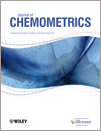A scientific instrument is a device or tool used for scientific purposes, including the study of both natural phenomena and theoretical research.
Chemometrics is the science of extracting information from chemical systems by data-driven means. Chemometrics is inherently interdisciplinary, using methods frequently employed in core data-analytic disciplines such as multivariate statistics, applied mathematics, and computer science, in order to address problems in chemistry, biochemistry, medicine, biology and chemical engineering. In this way, it mirrors other interdisciplinary fields, such as psychometrics and econometrics.
Partial least squares regression is a statistical method that bears some relation to principal components regression; instead of finding hyperplanes of maximum variance between the response and independent variables, it finds a linear regression model by projecting the predicted variables and the observable variables to a new space. Because both the X and Y data are projected to new spaces, the PLS family of methods are known as bilinear factor models. Partial least squares discriminant analysis (PLS-DA) is a variant used when the Y is categorical.

Laser-induced breakdown spectroscopy (LIBS) is a type of atomic emission spectroscopy which uses a highly energetic laser pulse as the excitation source. The laser is focused to form a plasma, which atomizes and excites samples. The formation of the plasma only begins when the focused laser achieves a certain threshold for optical breakdown, which generally depends on the environment and the target material.
Trumpet Winsock is an implementation of the Winsock application programming interface for Windows 3.x developed by Peter Tattam from Trumpet Software International. It was a shareware program that had a TCP/IP stack.

An electronic nose is an electronic sensing device intended to detect odors or flavors. The expression "electronic sensing" refers to the capability of reproducing human senses using sensor arrays and pattern recognition systems.

The Journal of Chemometrics is a monthly peer-reviewed scientific journal published since 1987 by John Wiley & Sons. It publishes original scientific papers, reviews, and short communications on fundamental and applied aspects of chemometrics. The current editor-in-chief is Age K. Smilde.

Electrophoresis is a peer-reviewed scientific journal covering all aspects of electrophoresis, including new or improved analytical and preparative methods, development of theory, and innovative applications of electrophoretic methods in the study of proteins, nucleic acids, and other compounds.
The Chemical Structure Association Trust is an internationally recognized, registered charity which promotes education, research and development in the field of storage, processing and retrieval of information about chemical structures, reactions and compounds. Since 2003 it has incorporated the activities of the former Chemical Structure Association.
Genes, Brain and Behavior is a peer-reviewed online-only scientific journal covering research in the fields of behavioral, neural, and psychiatric genetics. It is published by Wiley-Blackwell on behalf of the International Behavioural and Neural Genetics Society. The journal was established in 2002 as a quarterly and is currently published monthly. G2B is a hybrid open access journal, but two years after publication all content is available for free online.
The Unscrambler X is a commercial software product for multivariate data analysis, used for calibration of multivariate data which is often in the application of analytical data such as near infrared spectroscopy and Raman spectroscopy, and development of predictive models for use in real-time spectroscopic analysis of materials. The software was originally developed in 1986 by Harald Martens and later by CAMO Software.
Richard D. Braatz is the Edwin R. Gilliland Professor at the Massachusetts Institute of Technology known for his research in control theory and its applications to chemical, pharmaceutical, and materials systems.
Orthogonal Signal Correction (OSC) is a spectral preprocessing technique that removes variation from a data matrix X that is orthogonal to the response matrix Y. OSC was introduced by researchers at the University of Umea in 1998 and has since found applications in domains including metabolomics.

The Journal of Magnetism and Magnetic Materials is a peer-reviewed scientific journal that covers both basic research on magnetism and technological applications including magnetic recording. In addition to full-length research articles, it publishes review articles and rapid communications. A special section, "Information Storage: Basic and Applied", covers topics on magnetic media. The editor-in-chief is S. D. Bader.
SLAS Technology is a peer-reviewed scientific journal published by the Society for Laboratory Automation and Screening in partnership with Elsevier. The editor-in-chief is Edward Kai-Hua Chow, Ph.D.. The journal explores ways in which scientists adapt advancements in technology for scientific exploration and experimentation, especially in life sciences research and development. This includes drug-delivery; diagnostics; biomedical and molecular imaging; personalized and precision medicine; high-throughput and other laboratory automation technologies; micro/nanotechnologies; analytical, separation and quantitative techniques; synthetic chemistry and biology; informatics ; and more. The journal was published from 1996 through 2016 with the title Journal of Laboratory Automation. Its name changed in 2017 to more accurately reflect the evolution of its editorial scope.[1]

The Journal of Synchrotron Radiation is a peer-reviewed scientific journal published by Wiley-Blackwell on behalf of the International Union of Crystallography. It was established in 1994 and covers research on synchrotron radiation and X-ray free-electron lasers and their applications. In January 2022, Journal of Synchrotron Radiation became a fully open access journal.

Dr. Agnar Höskuldsson is a Danish scientist who specializes in the field of chemometrics. He was formerly an associate professor at the Technical University of Denmark. He was awarded the Herman Wold gold medal for his contribution to chemometrics in 1997 and over the span of his career he has published over 30 scientific papers and is credited with over 2000 scientific citations.
Elaine Barbara Martin OBE FREng FIChemE CEng is a chemical engineer and statistician and Head of School at the University of Leeds. She is a Fellow of the Institution of Chemical Engineers, Royal Statistical Society and Royal Academy of Engineering.

Vadym Slyusar – Soviet and Ukrainian scientist, Professor, Doctor of Technical Sciences, Honored Scientist and Technician of Ukraine, founder of tensor-matrix theory of digital antenna arrays (DAAs), N-OFDM and other theories in fields of radar systems, smart antennas for wireless communications and digital beamforming.







